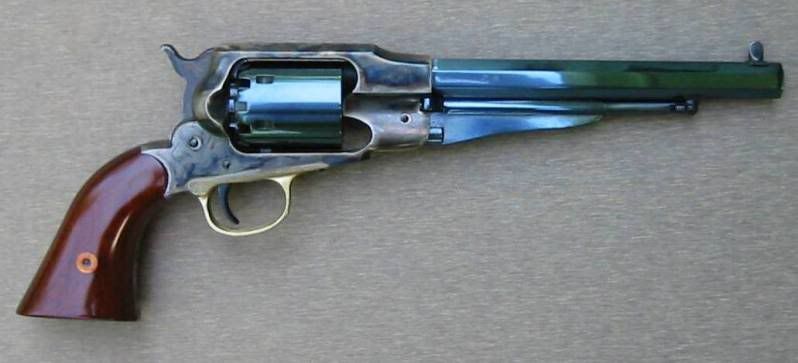I saw the picture for the winner of the June photo contest in another thread. It's a beautiful picture of Clembert's '58 Remington NMA.
http://www.thefiringline.com/forums/showthread.php?t=366512
I've got a question about the gun finish. Someone describes it as being " color-case" - which I assume refers to the coloring of the brass. My brass 58 Remmie is starting to get coloration like that just because I'm shooting it regularly (170 rounds so far, using *nothing but Holy Black*).
Clembert, did you shoot your gun to make it look like that or did you use some kind of artificial finish (I understand if it's some kind of trade secret <grin>)?
I've seen this kind of finish on other guns - 73 Winchesters for example. Is this a specific type of finish that's artificially applied or is it the result of the manufacturing process?
Maybe I should also add, is it a bad thing that my brass is looking like that? Personally I like that look - it makes it look like a real gun and not just a wall decoration. However, if it means there's a problem with the gun I'd like to know.
The only relevant background info I can think of (regarding the possibility of messing up my gun) is that when I first shot it I used 30 grain loads for the very first cylinder of shooting and then went immediately down to 25 grain loads. The coloration appeared the first day I shot it. I've only used that high a load 10 -15 out of my 170 shots so I'm thinking I'm doing OK but it doesn't hurt to ask.
http://www.thefiringline.com/forums/showthread.php?t=366512
I've got a question about the gun finish. Someone describes it as being " color-case" - which I assume refers to the coloring of the brass. My brass 58 Remmie is starting to get coloration like that just because I'm shooting it regularly (170 rounds so far, using *nothing but Holy Black*).
Clembert, did you shoot your gun to make it look like that or did you use some kind of artificial finish (I understand if it's some kind of trade secret <grin>)?
I've seen this kind of finish on other guns - 73 Winchesters for example. Is this a specific type of finish that's artificially applied or is it the result of the manufacturing process?
Maybe I should also add, is it a bad thing that my brass is looking like that? Personally I like that look - it makes it look like a real gun and not just a wall decoration. However, if it means there's a problem with the gun I'd like to know.
The only relevant background info I can think of (regarding the possibility of messing up my gun) is that when I first shot it I used 30 grain loads for the very first cylinder of shooting and then went immediately down to 25 grain loads. The coloration appeared the first day I shot it. I've only used that high a load 10 -15 out of my 170 shots so I'm thinking I'm doing OK but it doesn't hurt to ask.


